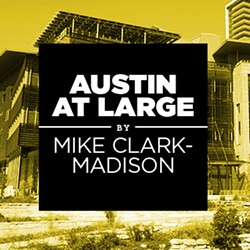Austin @ Large: Austin at Large
How Our Garden Grows: If Austin is so great, why should we keep it to ourselves?
By Mike Clark-Madison, Fri., Sept. 27, 2002

Which brings us to Envision Central Texas, the regional community-driven planning effort now under way. The object of ECT is, simplistically put, to figure out where to fit 1.5 million more people (which would double the current population) into the five-county metro area by 2025. If we actually give the matter some thought, ECT presumes, we can accommodate those people in ways that do less damage and produce more benefit than the current anything-goes growth pattern.
Most establishment types I know support ECT, or at least pay it proper lip service. I suppose we'll see the depth of their commitment as soon as some developer is told he can't build his ranchettes in such-and-such a place because ECT said so. But based on the first ECT workshop, held two weeks ago at the Convention Center, suburban developers could be sitting on a goldmine -- the strongest theme I saw among the participants' ideas was more dense and intense development in existing towns and along already established corridors.
That's the kind of buildout -- big infill -- that is so controversial within the Austin city limits, and that developers say they can't do here because the neighbors object, the city burdens them with red tape, and the land is so expensive. Well, I imagine the neighbors in Cedar Park or Dripping Springs or Lockhart will also object, but there are fewer of them and fewer lawyers and architects among those. Those cities, on the other hand, have gotten quite good at touting the ease (compared to Austin) of development in their domains, and the land is cheap. If I were in the sprawl business, I'd be looking to build mixed-use instead in Round Rock (which needs it a lot more badly than does most of Central Austin).
Flowers or Weeds
But so far, what rancor and unease there is about ECT has come from the querulous center-city True Left, my friends among the Tribe. Their objection is twain: Because ECT has mainstream support and funding from people who build highways and support sprawl, and because it presumes we will have 100% growth in 20 years like-it-or-not, the project is to be suspected, or feared, and closely watched, or shunned.
I suppose if ECT's marquee planners, John Fregonese and Peter Calthorpe, produce a growth map that makes sense, certain Austin progressives may overcome their natural suspicion of the establishment forces (CAMPO, LCRA, suburban counties, the Chamber, Will Wynn) that made ECT possible. Or maybe not, in which case they will demonstrate why I call them a Tribe. Whatever. I'm more concerned about the second half of the equation: that ECT will stick us with growth that we can otherwise avoid.
It's obvious that we'll continue to grow, but we could certainly discourage growth substantially with the proper scowling, bad attitude, and onerous regulation. Other cities have, and many would argue the city of Austin has also, shifting the center of local gravity just outside the city limits. (I've found that Tribalists have an exaggerated notion of how much "incentive" the city has offered to developers in recent years; it's still a lot cheaper and easier to build in the suburbs.) But if the goal is to preserve Austin's unique character and highly developed sense of special-ness, I think clamping down on growth is about the very worst thing we could do.
If We Don't Build It, They'll Still Come
Now, to be clear: Managing growth, of which I am very fond, is quite different. That is why we need a proper comprehensive plan in Austin that we actually follow -- as we failed to do with Stratus. That is why, despite its bad reputation, we need a Smart Growth Initiative. And that is why we need to try something like ECT, which could make a difference precisely because it includes people in suits from the 'burbs. If we don't like the results, fine, but not attempting to plan is the way of the ostrich.
Simply saying "No growth!" is, well, stupid. And unfair. Many progressive communities have succeeded in limiting growth -- Boulder, Colo., Santa Fe, my old stomping grounds in Santa Barbara, Calif.. The result has, almost uniformly, been an affordability crisis that puts Austin's in the shade, a loss of the true urban vitality that comes from both cultural and economic diversity, and destructive boom in neighboring communities which don't have such rigid attitudes. The traffic's just as bad, the air's just as bad, the water's just as scarce, and income segregation is even worse than it was before.
To say these towns have preserved "quality of life" is to say that some animals are more equal than others. Ironically, these are all communities with pretensions of populism. In Austin, those pretensions are a lot more genuine, but it won't be long before center city Anglo neighborhood leaders, seeking to keep their precincts the islands of the blessed, will lose the right to be treated as "ordinary citizens" rather than an elite.
In the "Best of Austin" readers poll elsewhere in this issue, our readers -- including, I suppose, the famous Core Readers -- said "the people" were the best thing about Austin. There are plenty of people in Austin whose own dreams -- for themselves and for their city -- will be better fulfilled if Austin were a bigger city. Their quality of life is no less important than that of prog-libs who think we should emulate Boulder. And the people who will keep Austin weird and special tomorrow may not even live here yet. We shouldn't discourage them from coming.
Got something to say? The Chronicle welcomes opinion pieces on any topic from the community. Submit yours now at austinchronicle.com/opinion.






